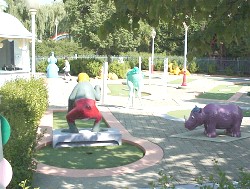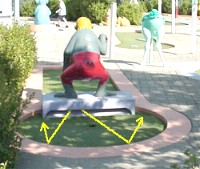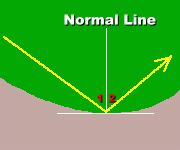
 After successfully avoiding the danger of the stand-up roller coaster, we happened to stroll by a mini-golf course, and we were reminded of the Law of Reflection from Physics 20.
After successfully avoiding the danger of the stand-up roller coaster, we happened to stroll by a mini-golf course, and we were reminded of the Law of Reflection from Physics 20.
This little course makes it look much more difficult to judge the angle of your shot, because many of the walls are curved. However, the laws of reflection still work. Let's have a look.
 When you hit the ball, it will strike the wall and bounce off. You must estimate the correct spot to hit the wall so that the ball will bounce off at a favourable angle. When you hit the ball, it will strike the wall and bounce off. You must estimate the correct spot to hit the wall so that the ball will bounce off at a favourable angle.
If the ball were tiny and the surface of the wall rough, or if the wall were curved much more strongly, then it would be difficult to predict where the ball would go.
But the golf ball is large in comparison to the bumps on the surface of the wall (it was fairly smooth), and the curve of the wall is large compared to the size of the ball.
All this means that we can assume that where the ball hits the wall, the wall is flat.
This lets us use the Law of Reflection to estimate where the ball will go, just by looking.
 Here's a close-up.
Here's a close-up.
At the point of impact, we assume that the wall is flat.
The horizontal white line represents the wall's surface.
A line perpendicular to that is called the normal.
The Law of Reflection says that the angle of incidence (1) must equal the angle of reflection (2).
If the curved wall is a smooth circle, it's easier to line up your shot by making the outside angles (with the wall) equal.
|
Amusement Park Physics
|

 Here's a close-up.
Here's a close-up.